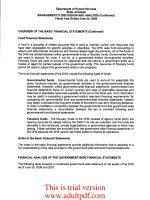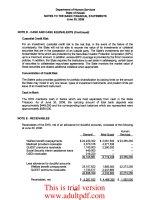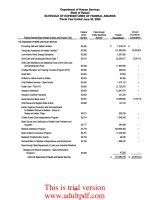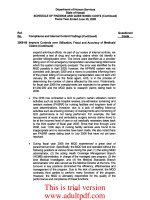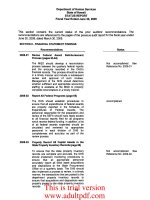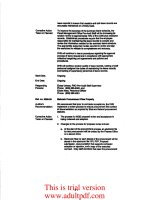Department of Human Services Child Support Enforcement Division Financial-Related Audit For the Period October 1, 1997, through March 31, 1999 October 1999 _part1 pot
Bạn đang xem bản rút gọn của tài liệu. Xem và tải ngay bản đầy đủ của tài liệu tại đây (64.21 KB, 10 trang )
Department of Human Services
Child Support Enforcement Division
Financial-Related Audit
For the Period October 1, 1997, through March 31, 1999
October 1999
Financial Audit Division
Office of the Legislative Auditor
State of Minnesota
99-54
Centennial Office Building, Saint Paul, MN 55155 l 651/296-4708
This document can be made available in
alternative formats, such as large print,
Braille, or audio tape, by calling 296-1727
SUMMARY
State of Minnesota
Office of the Legislative Auditor
1st Floor Centennial Building
658 Cedar Street • St. Paul, MN 55155
(651)296-1727 • FAX (651)296-4712
TDD Relay: 1-800-627-3529
email:
URL:
Department of Human Services
Child Support Enforcement Division
Financial Related Audit
For the Period October 1, 1997, through March 31, 1999
Public Release Date: October 1, 1999 No. 99-54
Background and Scope
The Department of Human Services manages Minnesota’s child support enforcement program. The
department maintains the state’s centralized child support information system (PRISM) and is responsible
for the statewide collection and distribution of child support payments. The child support enforcement
program was established in 1975 under Title IV-D of the Social Security Act. The program’s purpose is
to minimize public assistance payments by locating non-custodial parents, establishing paternity,
establishing and enforcing child support, and collecting child support to ensure that children are
financially supported by both parents.
Our audit scope was limited to specific child support enforcement activities under direct supervision, or
control of the Department of Human Services. We audited the period from October 1, 1997, when the
department implemented its new child support information system, through March 31, 1999. During that
period, the department collected and distributed more than $624 million of child support payments.
Specifically, this audit reviewed:
• controls over centralized child support collection,
• calculation and notification of child support cost of living adjustments,
• distribution of child support payments,
• security over and access to the state’s centralized child support computer systems, and
• payment of state funded child support enforcement bonus incentives.
Our audit was limited to state level controls over compliance. We did not review or evaluate any county
administrated child support activities.
Conclusions
Our audit found that the Department of Human Services generally designed and implemented controls to
ensure that child support payments were adequately safeguarded and promptly deposited. The department
accurately calculated and notified individuals of cost of living adjustments to child support obligations.
In addition, the department established adequate controls to ensure compliance with applicable legal
provisions regulating child support enforcement incentives paid to counties and medical providers.
We found, however, that the department did not always distribute incoming child support payments in
accordance with applicable legal provisions. Also, the department did not properly restrict PRISM users
with personal child support cases from accessing their own case information. Finally, the department did
not adequately secure certain system programming files and limit access to certain batch programs.
In its written response, the Department of Human Services agreed with the audit findings and is taking
corrective action to resolve the issues.
STATE OF MINNESOTA
OFFICE OF THE LEGISLATIVE AUDITOR
JAMES R. NOBLES, LEGISLATIVE AUDITOR
Representative Dan McElroy, Chair
Legislative Audit Commission
Members of the Legislative Audit Commission
Mr. Michael O’Keefe, Commissioner
Department of Human Services
We have audited select areas related to Minnesota’s child support enforcement program, which is
managed by the Department of Human Services’ Child Support Enforcement Division. Our audit scope
included the department’s child support collections process, cost of living increases, distribution of child
support, and controls over certain information systems used by the department for child support
enforcement. We also reviewed the department’s internal controls over compliance with legal
provisions related to state incentive payments made to counties and health care providers for child
support enforcement assistance. Our audit was limited to state level controls over compliance. We did
not review or evaluate any county administered child support activities. We emphasize that this has not
been a complete audit of the child support enforcement program, nor of the Department of Human
Services’ Child Support Enforcement Division. We further explain the scope of our audit in Chapter 1.
We conducted our audit in accordance with Government Auditing Standards, as issued by the
Comptroller General of the United States. Those standards require that we obtain an understanding of
management controls relevant to the audit. These standards also require that we design the audit to
provide reasonable assurance that the Department of Human Services complied with provisions of laws,
regulations, contracts, and grants that are significant to the audit. Management of the Department of
Human Services is responsible for establishing and maintaining the internal control structure and for
compliance with applicable laws and regulations.
This report is intended for the information of the Legislative Audit Commission and the management of
the Department of Human Services. This restriction is not intended to limit the distribution of this report,
which was released as a public document on October 1, 1999.
James R. Nobles Claudia J. Gudvangen, CPA
Legislative Auditor Deputy Legislative Auditor
End of Fieldwork: June 23, 1999
Report Signed On: September 28, 1999
1ST FLOOR SOUTH, CENTENNIAL BUILDING l 658 CEDAR STREET l ST. PAUL, MN 55155
TELEPHONE 651/296-4708 l TDD RELAY 651/297-5353 l FAX 651/296-4712 l WEB SITE
Department of Human Services’ Child Support Enforcement Division
Table of Contents
Page
Chapter 1. Introduction 1
Chapter 2. Child Support Collections 5
Chapter 3. Cost of Living Adjustments 9
Chapter 4. Distribution of Child Support 11
Chapter 5. Child Support System Security 15
Chapter 6. Child Support Incentive Bonuses 19
Status of Prior Audit Issues 21
Department of Human Services Response 23
Audit Participation
The following members of the Office of the Legislative Auditor prepared this report:
Claudia Gudvangen, CPA Deputy Legislative Auditor
Jeanine Leifeld, CPA, CISA Audit Manager
Mark Mathison, CPA, CISA Auditor-In-Charge
Fubara Dapper, CPA, CISA Auditor
Daniel Kingsley Auditor
Mike Willis Auditor
Exit Conference
We discussed the findings and recommendations of the audit with the following representatives of the
Department of Human Services on September 2, 1999:
Tom Moss Deputy Commissioner
Mary Orr Acting Assistant Commissioner, Economic and
Community Support
Laura Kadwell Director, Child Support Enforcement
Wayland Campbell Assistant Director, Child Support Enforcement
Wes Kooistra Chief Financial Officer & Budget Analysis Director
Mary Arveson Child Support Project Manager
Greg Poehling Child Support Payment Center Manager
David Ehrhardt Director, Internal Audits
Department of Human Services’ Child Support Enforcement Division
1
Chapter 1. Introduction
The Department of Human Services manages the Minnesota child support enforcement program
through its Child Support Enforcement Division. Currently, the state has over 225,000 child
support cases. About 33 percent of those cases receive public assistance and account for about
18 percent of child support collections. Conversely, about 67 percent of the child support cases
do not receive public assistance, and account for approximately 82 percent of the total
collections.
In Minnesota, child support enforcement is a “state supervised and county administered”
program. In this capacity, the Child Support Enforcement Division is responsible for the
developing programs and legislative initiatives, complying with numerous state and federal
regulations, corresponding with the federal Office of Child Support Enforcement, maintaining
the state’s centralized child support information system, and collecting and distributing child
support payments. In addition, the division is a liaison to the 84 county-operated child support
enforcement offices, providing them with oversight, information, support, and bonus payments
for the establishment of paternity, child support orders, adjustments to existing orders, and
medical support orders.
The federal government established the child support enforcement program in 1975 to help
reduce dependence on welfare by ensuring that the financial responsibility for supporting
children was placed on parents. Title IV-D of the 1975 Social Security Act required all states
participating in Aid to Families with Dependent Children to establish statewide child support
enforcement programs. Its purpose was to locate non-custodial parents, establish paternity,
establish and enforce child support, and collect child support payments to ensure that children
are financially supported by both their parents. An initial goal of child support efforts was to
recover payments made to recipients of public assistance. In the 1980s, the emphasis shifted to
reducing public assistance costs and reducing the need for public assistance, by making child
support enforcement services available to all custodial parents, whether they were on public
assistance or not. The program received additional modifications under the Personal
Responsibility and Work Opportunity Reconciliation (welfare reform) Act of 1996.
In the 1988 Federal Family Support Act, the federal government required each state to develop a
statewide automated data system that had the ability to control, account for, and monitor all
processes for determining paternity and collecting child support. Additionally, the system was
required to electronically interface with systems of other agencies at the federal, state, and local
level. In 1993, the Department of Human Services contracted with Technalysis Corporation for
the development of the new child support automated system. In mid-1995, both parties agreed to
terminate that contractual relationship. The department then contracted with Software AG of
North America to complete the system. The system was called Providing Resources to Improve
Support in Minnesota (PRISM). The PRISM system became operational on October 1, 1997.
As of September 1998, the department had expended approximately $30 million in the
development of the PRISM system. The department paid for the PRISM project with
Department of Human Services’ Child Support Enforcement Division
2
Inter-Agency
Computer Services
14%
Other
16%
Personnel
40%
Other Contractors
18%
Technalysis
27%
Software AG
55%
Contracts
30%
Source: Department of Human Services
approximately 16 percent state and 84 percent federal funds. Figure 1-1 shows percentage of
system development costs by category.
Figure 1-1
PRISM Development Costs by Category
As of September 1998
Audit Scope
This audit focused on certain functions of the Department of Human Services child support
enforcement program for the period from October 1, 1997, through March 31, 1999. Our audit
scope was limited to specific child support activities under the direct supervision or control of
the Department of Human Services. We did not review or evaluate any county administrated
child support activities. We emphasize that this has not been a comprehensive audit of the
Department of Human Services, nor of the child support enforcement program. Rather, we
selected certain components of the program for testing. Specifically, this audit reviewed:
• controls over centralized child support collections,
• calculation and notification of child support cost of living adjustments,
• distribution of child support payments,
• security over and access to the state’s centralized child support computer systems,
and
• payment of state funded child support enforcement bonus incentives to counties and
health care providers.
In determining our audit objectives, we considered that the federal Department of Health and
Human Services conducted a certification review of the PRISM system in 1998. The
certification was designed to provide assurance that the State of Minnesota’s PRISM system
Department of Human Services’ Child Support Enforcement Division
3
complied with federal requirements for processing child support. The Status of Prior Audit
Issues discusses the federal certification report in more detail.
We also considered several questions and complaints we have received about the department’s
processing and payment of child support. We considered these concerns when designing the
methodology and testing plans for this audit.
Department of Human Services’ Child Support Enforcement Division
4
This page intentionally left blank.
Department of Human Services’ Child Support Enforcement Division
5
Chapter 2. Child Support Collections
Chapter Conclusions
The Department of Human Services designed and implemented controls to
provide reasonable assurance that child support collections were adequately
safeguarded and promptly deposited. However, the department could enhance
security over these receipts by performing criminal background checks on
potential employees who will have access to, or control over, child support
collections. The department accurately accounted for child support collections
within the applicable accounting systems.
The department contracts with a private organization for the collection of child
support payments. The contract appears to adequately safeguard the interests
of the state. It provides sufficient oversight by the state and limits the state’s
liability in case of theft.
The child support enforcement program is responsible for collecting child support obligations
from non-custodial parents; and for distributing those funds, either to reimburse public
assistance, or to compensate custodial parents. Federal and state regulations require public
assistance recipients to participate in the child support enforcement program and to assign their
rights to child support and maintenance back to the state. For custodial parents on public
assistance, the child support collected from non-custodial parents goes to reimburse the state and
federal government for assistance paid to the families.
Child support services are also available to families not receiving public assistance. The state
charges those families a one-time application fee of $25 to allow them to participate in the
program. Child support payments that are collected on behalf of non-public assistance families
are sent to the custodial parent.
Prior to October 1, 1997, child support collections and distributions occurred at each of the 84
county social service centers. With the implementation of the PRISM system in October 1997,
child support collections still occurred at the county level. However each county recorded the
receipts into the PRISM system and deposited those funds into a state depository. The
Department of Human Services then distributed the child support payments. State and federal
laws require the department to centrally collect and disburse child support payments. On
October 1, 1998, the department began its centralized collection and payment center for child
support.
From October 1, 1997, through March 31, 1999, the Department of Human Services collected
and distributed over $624 million in child support payments. Each day, the department processes
about 8,000 collection transactions and makes average deposits exceeding $1 million. Although
Department of Human Services’ Child Support Enforcement Division
6
child support is now generally being collected centrally for the entire state, counties still collect a
minimal amount of child support payments. The department requires counties to have a process
in place to collect payments from non-custodial parents. Beginning November 1, 1998, all child
support payments that counties collect go to the state for processing.
Audit Objectives and Methodology
Our objectives in auditing the collection of child support payments were to answer the following
questions:
• Did the Department of Human Services design and implement a control system to
adequately safeguard incoming child support receipts?
• Did the department deposit incoming child support receipts in a timely manner, in
accordance with Minn. Stat. Section 16A.275?
• Did the department accurately account for child support collections within the applicable
accounting systems?
• Does the contract with the private organization for the collection of child support
payments adequately safeguard the interests of the state?
To answer these questions, we interviewed key staff from the Department of Human Services
and from the private child support collections vendor. We reviewed policies and procedures and
observed child support payment center operations. We also tested samples of transactions to
determine if receipts were properly and promptly deposited and accurately recorded into the
various systems. We verified that the department had successfully reconciled the various child
support systems.
We reviewed the contract between the department and Services Design Associates (SDA), the
private child support collections vendor. We met with management to determine the reasons for
outsourcing the collection process. Further, we reviewed a feasibility study done in 1994 which
assessed the costs/benefits of establishing a centralized collection center for the State of
Minnesota. We reviewed the terms of the department’s contract with SDA to determine whether
it adequately safeguarded the interests of the state. Finally, we reviewed bonding and insurance
policies for both the department and SDA.
Private Collections Vendor
The Department of Human Services operates its centralized collection center in conjunction with
a private vendor that specializes in child support collections. In 1998, the department outsourced
its collection process to Services Design Associates (SDA), a Division of Tier Technologies.
Pursuant to the contract, SDA employees process incoming child support payments. SDA
employees are housed within a Department of Human Services facility, using computers
supplied by the department. All processing exceptions, such as unidentifiable checks, are
handled by department employees. The contract with SDA provides for a two-year contract

